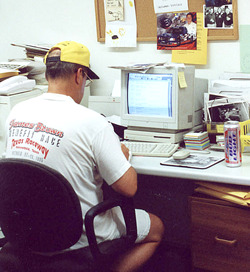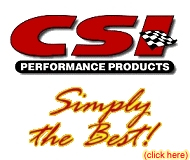|
|
 |
||||||||||||||||||||||||||||||
 |
|||||||||||||||||||||||||||||||
RAMBLIN' THROUGH APRIL There's this guy Bob Francis, who is an automotive historian and has penned three really good books on the history of cars. He also contributes a column to the St. Louis Post Dispatch called "This Week in Auto History," where he shares interesting tidbits of arcane and not-so-arcane information to the automotively-bent reader. For the week beginning April 9, I came across that column and discovered some items where I could say (in most cases), "Hey, I didn't know that." For example, on April 11, 1938, the trustees of the Pierce-Arrow Corp., were ordered to pull the plug on the classic old early century touring car. Three years later, also on April 11, lovable old Hitler aficionado, Henry Ford Sr., the last holdout against an organized automotive labor force, caved in and allowed the United Auto Workers to operate. On a lighter note, though, on April 14, 1957, Ford Motor Company produced the first Skyliner retractable hardtop convertible. It featured a steel top that could be automatically stowed in the trunk via a series of electric motors, limit switches, and relays. President Dwight Eisenhower was presented the first one (MSRP: $2,942) on April 14, and he was so enthused that he wanted to drive it at the presentation. The next morning he disappeared for a few hours, but was found in the trunk after his coat sleeve got caught in the plumbing of the unit and was filtered through the system into the back of the car. Finally on April 17, 1964, Ford introduced its Mustang and 20,000 of the $2,372 list priced cars were ordered on the first day.
Out of all the automotive happenings like the above, though, the one that most raised my eyebrows was the one announced in Kenosha, Wisconsin on April 14, 1950. American Motors unveiled the Nash Rambler, arguably America's first compact car, at a special press conference. The little tyke then came only as a convertible and listed for $1,808 fully equipped. If there ever was a "cute" car, the Nash Rambler was it. The thing was even the key subject in a hit rock n' roll song of 1958 called "Beep, Beep" by the Playmates. It was about how a little Nash Rambler outran a multi-inch Cadillac in a top-end punch. The little car that could looked like something Porky Pig and Daffy Duck would drive in a Warner Bros. cartoon ... and in that dig are some of the seeds for the company's eventual unraveling. Despite all that, AMC got in on the ground floor in the compact class with only European makes being exempt. British Leyland cranked out some stylish roadsters as did the Italians and Germans, and if you were a young person and wanted to look way past cool, you went overseas for your convertible. Today, I look back on the little Nash and see them as unique, historically and aesthetically. Hell, if they had an automatic transmission, I'd even like to own one. Just enough room for gas and my ass and away we go! A few years later, the little Rambler was eaten by the competition. The Chevrolet Corvette came out in 1953 and the Ford Thunderbird in 1955. They were all super sporty cars, and they just totally outclassed the AMC. Even the Volkswagen "Beetle" of the early 1950s, was cuter to the masses. And there lies what I think was the chief factor in the demise of the American Motors Company. I don't know enough mechanically to critique engines and transmissions, but I do know that there was no loonier group of designers collected in one spot than the creative minds at AMC. AMC cars swung the bat hard in every at-bat of a new model year - and missed big. The designers were just too conservative. That bilge might work in politics but not with the auto buying public. The American looked so restrained, the rear fins courteously curved and the overall package so boxy that only someone with blue hair and a few years away from a death bed would even contemplate something so stifling. The 1960 American looked like a music box. After the issuance of five years worth of American Motors Rambler Americans (roughly 1960), the factory got the label of an "old person's car" (at least in my neighborhood). AMC was the Lawrence Welk of automotive factories. If you were graduating from high school at that time and you had parents who could afford a new car for you, asking for a Rambler American would be social suicide. You'd have been taken out behind the gym and brutally stomped for such inept decision-making. It would be like contacting a drug dealer and asking for aspirin. And if the Americans were off base, the fabled Rambler Marlins of 1966 were thrown out trying to steal the on-deck circle. Hard as it is to imagine, the Marlin was too radical, but not in "Wow-what-a-breakthrough" sense; more like an "Oh-No-Where's-My-Gun?" kinda fix. The AMC Marlin kinda looked like a marlin. A gigantic black fast back that extended from the front window and slowly descended, with no interruption, to the rear bumper. If the thing had been driven into a lake up to its door handles, a drunken fisherman would've been justified in saying he'd seen a monster. One bold racer did achieve modest fame with a Rambler Marlin. Preston Honea ran one as a Funny Car in 1966, and that was one of the few times that the term "funny car" applied to the competition, literally. For drag racing fans, Ramblers did excel for brief moments. Hayden Proffitt ran a Rambler Rebel SST Funny Car in 1967, Dick Bourgeois and Marv Eldridge drove Javelins a few years later, and Pro Stock racers Wally Booth and the team of Rich Maskin and Dave Kanners did extremely well with AMC Hornets. Booth won the '74 Gatornationals and the '76 U.S. Nationals and World Finals with one. Even NHRA Super Comp super star Edmond Richardson started out winning Super Street races with the impossibly lame looking AMC Gremlin. But that was it. And that's it here for rambling through April. Next month our topic will be "Moving in May." How yours truly tries to tie drag racing into a return to Los Angeles from St. Louis.
photo of Chris Martin by Jeff Burk |
|
||||||||||||||||||||||||||||||
|
Copyright 1999-2001, Drag Racing Online and Racing Net Source |
|
||||||||||||||||||||||||||||||




